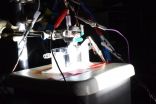(Press-News.org) GAINESVILLE, Fla. -- Larger and private colleges and universities seem to attract hookah cafes and lounges, but smoke-free policies decrease these odds, according to findings published in the American Journal of Preventive Medicine this month.
That may bode well for the long-term health of college-age students.
Waterpipe smoking, more commonly known as hookah, boasts enticing flavors and a healthier reputation, increasing its popularity among college students. It is estimated that more than 10 percent of U.S. college students are current users.
However, recent evidence refutes claims that hookah is less harmful than cigarettes. According to the Centers for Disease Control and Prevention, hookah contains many of the same harmful toxins as cigarette smoke and has been associated with lung cancer, respiratory illness, low birth weight and periodontal disease.
"Waterpipe smoking establishments are almost entirely unregulated, and there is very little information available on the industry's expansion," said Ramzi Salloum, Ph.D., an assistant professor in the department of health outcomes and policy in the UF College of Medicine, who led the study. "Given the industry's appeal for young adults and its efforts to target this age demographic, since many of them are under the legal drinking age, it is crucial to document hookah establishments' proximity to colleges and universities and note the impact smoke-free campus policies can have."
A greater density of hookah establishments may promote hookah smoking, as higher numbers of tobacco retailers have been associated with higher levels of cigarette smoking, according to the researchers.
The researchers identified 1,690 establishments nationwide that offered waterpipe smoking in the fall of 2014 using online directories, compared with an estimated 725 outlets in a study from 2010. This
total likely underestimates the number of actual establishments, since not all of them are listed in online directories, which included Yelp, Hookah-Hookah, the Better Business Bureau and Hoover's directories. Although the methods for calculating the numbers in these two studies differ, it appears the industry is rapidly expanding.
Among the 1,454 colleges and universities with residential student populations greater than 250 around the country, 554, or 38 percent, had at least one establishment that offered hookah within 3 miles, and 719, or 50 percent, had at least one within 9 miles. When examining differences by the size of the institution, 75 percent of institutions with more than 20,000 full-time students had at least one establishment within 3 miles, compared with 30 percent of institutions with fewer than 2,500 students. In addition, hookah establishments were almost twice as likely to be located near private institutions compared with public institutions.
"Economic factors may be at work here, with the stronger purchasing power of students attending private institutions accounting for the increased odds," Salloum said.
However, both private and public institutions with smoke-free campus policies were almost half as likely to have a hookah establishment within 3 miles. These decreased odds could stem from the fact that institutions of higher education with smoke-free campus policies are located in a larger jurisdiction with stronger smoke-free laws or that hookah establishments are discouraged from locating in the immediate vicinity of the smoke-free campuses, according to the researchers.
"We hope that our findings will prompt state and local governments to consider targeted regulations that ban or limit these establishments near educational institutions and that waterpipe smoking regulations are included in campuswide tobacco-related policies," said Wasim Maziak, M.D., Ph.D., a professor at Florida International University and one of the collaborators on the study, along with researchers from the University of Florida, the University of South Carolina and the University of Michigan. "Hookah smoking places our youth at a health risk and must be taken seriously as part of the larger fight against tobacco and the preventable diseases it causes."
INFORMATION:
MADISON, Wis. -- Hydrogen could be the ideal fuel: Whether used to make electricity in a fuel cell or burned to make heat, the only byproduct is water; there is no climate-altering carbon dioxide.
Like gasoline, hydrogen could also be used to store energy.
Hydrogen is usually produced by separating water with electrical power. And although the water supply is essentially limitless, a major roadblock to a future "hydrogen economy" is the need for platinum or other expensive noble metals in the water-splitting devices.
Noble metals resist oxidation and include many ...
Societies are failing women, children and adolescents, particularly in the poorest communities around the world, and urgent action is needed to save lives and improve health, say global health experts.
In a special supplement published today by The BMJ, public health experts from around the globe highlight the critical actions and investments that will have the greatest impact on the health and well-being of women, children and adolescents.
The 15 papers in this special supplement outline the current evidence, identify successes as well as critical gaps in progress, ...
Montreal, September 14, 2015 - Using extensive genetic data compiled by the UK10K project, an international team of researchers led by Dr. Brent Richards of the Lady Davis Institute at the Jewish General Hospital has identified a genetic variant near the gene EN1 as having the strongest effect on bone mineral density (BMD) and fracture identified to date. The findings are published in the forthcoming issue of the prestigious journal Nature.
"EN1 has never before been linked to osteoporosis in humans, so this opens up a brand new pathway to pursue in developing drugs to ...
BLOOMINGTON, Ind. -- A study three years ago sparked a medical mystery when it revealed a part of the brain not found in any present-day anatomy textbooks.
Recently, Indiana University computational neuroscientist Franco Pestilli and an international research team published an article in the journal Cerebral Cortex that suggests this missing part of the brain may play an important role in how we understand the world -- despite getting "lost" for more than a century.
A long flat bundle of nerves called the vertical occipital fasciculus, or VOF, the structure appeared ...
Researchers at Cardiff University have devised a way of increasing the yield of biodiesel by using the waste left over from its production process.
Using simple catalysis, the researchers have been able to recycle a non-desired by-product produced when biodiesel is formed from vegetable oil, and convert this into an ingredient to produce even more biodiesel.
It is believed this new process will have significant environmental benefits by improving the yield of biodiesel in a sustainable way that doesn't require the use of additional fossil fuels, and could potentially ...
PROVIDENCE, R.I. [Brown University] -- Terahertz radiation could one day provide the backbone for wireless systems that can deliver data up to one hundred times faster than today's cellular or Wi-Fi networks. But there remain many technical challenges to be solved before terahertz wireless is ready for prime time.
Researchers from Brown University have taken a major step toward addressing one of those challenges. They've developed what they believe to be the first system for multiplexing terahertz waves. Multiplexers are devices that enable separate streams of data to ...
(SACRAMENTO, Calif.) -- Vitamin D insufficiency among the elderly is highly correlated with accelerated cognitive decline and impaired performance, particularly in domains such as memory loss that are associated with Alzheimer's disease and dementia, researchers with the UC Davis Alzheimer's Disease Center and Rutgers University have found. The effect is "substantial," with individuals with low vitamin D declining at a rate three times faster than those with adequate vitamin D levels.
The researchers said their findings amplify the importance of identifying vitamin D ...
Vitamin D insufficiency was associated with faster decline in cognitive functions among a group of ethnically diverse older adults, according to an article published online by JAMA Neurology.
In addition to promoting calcium absorption and bone health, vitamin D may influence all organ systems. Both the vitamin D receptor and the enzyme that converts 25-hydroxyvitamin D (25-OHD) to the active form of the vitamin are expressed in all human organs, including the brain. Thus, research has increasingly examined the association between vitamin D status and a variety of health ...
To encourage hospitals to improve quality of care, Medicare penalizes those with higher than expected rates of readmission within 30 days of discharge. The logic behind the penalties is that if patients receive high quality care, including proper discharge planning, they should be less likely to end up back in the hospital.
This seems straightforward, but it turns out that the social and clinical characteristics of a hospital's patient population that are not included in Medicare's calculation explain nearly half of the difference in readmission rates between the best- ...
Black children were less likely to receive any pain medication for moderate pain and less likely to receive opioids for severe pain than white children in a study of racial disparities in the pain management of children with appendicitis in emergency departments, according to an article published online by JAMA Pediatrics.
Racial and ethnic differences in the emergency department (ED) management of pain have been described, with lower rates of opioid prescription for black and Hispanic patients than for white patients. However, there are fewer studies in children. Appendicitis ...



